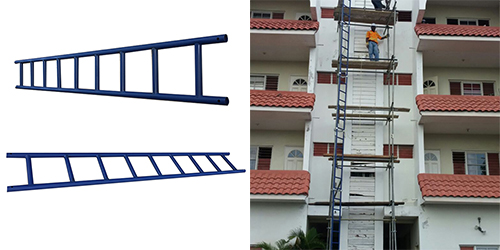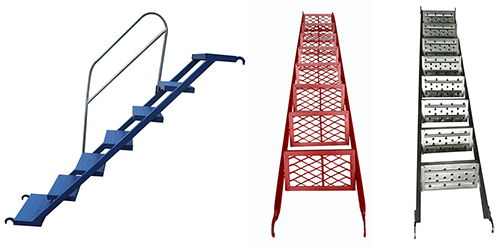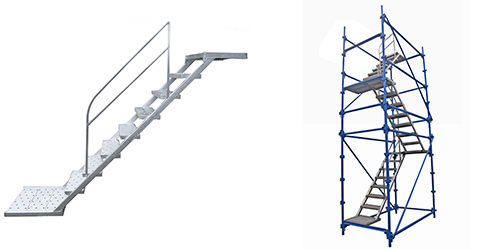Scaffold Access Ladder Requirements
Jan 18, 2024As a construction contractor, understanding different types of scaffolding ladders and their installation requirements is crucial to ensuring the construction environment and protecting the lives of workers.
1. Straight ladder
Straight ladders are a common type of scaffolding system. Their structural design allows them to be easily connected to the horizontal crossbars of the scaffolding, making them simple and convenient to use. When we choose a scaffolding straight ladder, we should ensure that its material is durable and can withstand the weight of workers and tools.

Inclined ladders are suitable for taller scaffolding systems, allowing workers to easily climb to the required height. There are two main styles of inclined ladders: with hooks and without hooks. When using an inclined ladder, we need to ensure that its angle and connection method comply with the design standards of the scaffolding system, so as to ensure safe use.


Scaffolding system preparation--ladders and scaffolding
Before installing steel scaffolding ladders, construction contractors need to ensure that the scaffolding system has been correctly erected. Make sure the connections between horizontal crossbars and vertical poles are strong to provide solid support for the installation of the scaffolding ladder.
AJ Building provides steel prop systems, ringlock scaffolding systems, frame scaffolding systems, quicklock scaffolding system, etc. Welcome to consult.
Correct connection and locking
When connecting the ladder, we must ensure that the connection point (hook) of the ladder is correctly aligned with the scaffolding crossbar and locked at the appropriate connection position. This step is to ensure the stability of the scaffolding ladder and prevent the risk of the ladder falling off during use.
4:1 Rule: For fixed ladders, the angle between the ladder and the horizontal should be approximately 75.5 degrees (1:4 ratio). This ensures easy climbing and reduces the likelihood of slipping.
Anti-slip measures
If your environment is humid or it rains frequently, we recommend that you add anti-slip measures to scaffolding ladders and scaffolding platforms to improve workplace safety.
Slip Resistance: Rungs should be corrugated, knurled, dimpled, or coated with skid-resistant material.
Side Rails
Extension: Side rails must extend at least 36 inches above the top landing, platform, or parapet to provide a handhold for getting on or off the ladder.
Strength: Rails must be strong enough to support the weight of a worker and any tools or materials they might be carrying.
Width
Clear Width: The minimum clear distance between the sides of individual-rung/step ladders or the minimum clear width of fixed ladders must be 16 inches, allowing for comfortable foot placement.
Load Capacity
Duty Ratings: Ladders are often rated for different duty levels:
Light Duty: Up to 200 lbs.
Medium Duty: Up to 225 lbs.
Heavy Duty: Up to 250 lbs.
Extra Heavy Duty: Up to 300 lbs or more.
Cages Or Wells
Height Requirement: For ladders over 24 feet, a cage or well must start at a height of 7 feet from the bottom of the ladder or access level.
Cage Design: Cages should:
Have a minimum inside diameter of 27 inches.
Extend at least 42 inches above the top landing or platform.
Be made of materials that do not obstruct the climber's view.
Access
Clear Path: The path to the ladder should be clear of obstructions, and there should be sufficient space for a worker to safely approach and use the ladder.
Landing Requirement: The bottom step or rung should not be more than 24 inches above the landing, and the ladder should be secured to prevent movement.
Stability
Securing: Ladders should be secured at the top, bottom, or both to prevent movement. Non-slip feet or ladder shoes can be used if the ladder is not fixed.
Inspection
Pre-Use Checks: Before each use, ladders must be inspected for:
Structural integrity (no cracks, broken rungs, or loose parts).
Corrosion or rust, especially in metal ladders.
Splits or rot in wooden ladders.
Proper functioning of safety devices like cages or wells.
Access To Platforms
Extension: Ladders should extend at least 3 feet above the point of access to the platform, allowing workers to step off safely.
Fall Protection
Safety Devices: For fixed ladders over 24 feet, additional fall protection might include:
Fall arrest systems (harnesses, lanyards, and anchors).
Ladder safety devices like sliding sleeves or other mechanisms that attach the worker to the ladder.
Safety signs and markings
We recommend placing clear safety signs around scaffolding ladders, including maximum number of people carrying them, safety warnings, etc. This helps remind workers to pay attention to safety when using it and use it correctly.
Worker training and supervision
For workers, it is necessary to provide them with professional training on the use of scaffolding ladders, and establish a supervision mechanism to ensure that workers always use scaffolding ladders correctly and in accordance with regulations.
Through the above points, we can more comprehensively ensure that the installation and use of scaffolding ladders meet standard safety requirements. In addition to scaffolding ladders, workers also need to follow correct installation steps and standards when building scaffolding platforms. Only in this way can we provide workers with a safe working environment.
AJ Building has been involved in the construction field for more than 20 years. We provide you with one-stop building materials, allowing you to purchase conveniently and save trouble, effort and worry. Please contact us!
Are You Allowed To Put A Ladder On Scaffolding?
What Are The Osha Requirements For Access Ladders?
What Is The Proper Way To Access A Scaffold?
Scaffolds, Ladders, And Lifts -- AGC
Scaffold And Ladder Safety -- EHS